As meat industry sales go down, the United States is experiencing a huge surplus of animal products sold as food. Currently supplies of chicken, beef, pork, turkey, and milk far outweigh demand.
And yet, even with an excess of chicken in cold storage, the USDA is granting waivers for chicken slaughterhouses to increase line speeds and kill even more birds per minute. A gut-wrenching Compassion Over Killing investigation at Amick Farms in Maryland recently revealed the horrors happening behind the closed doors of one of these high-speed slaughter plants.
The question is: with too much chicken in storage already, why increase kill line speeds?
This is an issue of animal cruelty and worker safety–and also brings to light corporate greed and massive amounts of food waste.
Chicken Surplus Meets High Speed Slaughter
The poultry industry is reporting a loss of demand for chicken products, leading to huge stocks of meat in cold storage facilities. This, it would seem, is becoming a trend: leading up to Thanksgiving, sales of turkey were doing poorly. Companies are experiencing huge oversupplies and dips in profit, including some companies losing millions of dollars and others shutting down entirely.
Yet, instead of reducing production as demand plummets, it would seem that the industry is putting the blame on consumers.
Susan Kelly writes on industry news site Meatingplace, “Consumer demand for chicken is failing to keep up with supply as broiler inventories build in freezers…”
As the USDA grants waivers for more chicken slaughter plants to operate at higher kill line speeds, it would seem that the fault is with chicken producers who are recklessly (and increasingly) creating supply without demand to back it up. And this needless supply comes at a heartbreaking cost to animals, workers, and the planet.
Not Just Meat–Dairy Too
According to research done for The Guardian, 128 million tons of milk are wasted annually. This happens during production, delivery, in retail, and at the hands of the consumer.
What’s really baffling is that the dairy industry continues to produce more milk despite souring consumer demand–which means more animals exploited and even more product wasted.
More milk means more cheese, which is easier to store. As of June 2018 this has resulted in a cheese stockpile of 1.3 billion pounds. And instead of decreasing production or switching to more lucrative vegan products, dairy producers are often bailed out by the USDA, which purchases the excess product. Instead of pivoting towards a more marketable and sustainable product that consumers want, the industry can just rely on government bailouts to stay afloat.
Sick Consumers = Wasted Food
Factory farms may even be the cause of produce waste. As the United States continues to struggle with E.Coli outbreaks in romaine lettuce, some experts speculate that strains could be linked to concentrated animal feeding operations, or CAFOs.
Following an outbreak traced to a source in Yuma, Arizona this summer, the FDA traced the strain to water used for irrigation that was possibly tainted by a nearby factory farm.
These farms pose a very serious threat to nearby communities and produce-growers. This summer, COK investigated the devastating aftermath of Hurricane Florence, which caused huge animal waste cesspools to overflow into the Cape Fear Watershed (in addition to the deaths of millions of animals who were abandoned on farms in the storm). The effects of these toxic spills on the community remain to be seen.
Reduce Waste, Eat Plants
With the planet in peril, a way we can easily decrease our environmental footprint is by simply eating plants. COK’s Erica Meier recently penned a powerful Medium article with a call to action to use our forks to fight climate change with vegan eating. Currently, huge amounts of land are dedicated to grow food to raise animals, who are then slaughtered, processed, and fed to consumers. By cutting out the middleman–or cow–we can save water and land, feed more people, and shorten the supply chain.
To get started, check out the many animal-free recipes on TryVeg.com.

